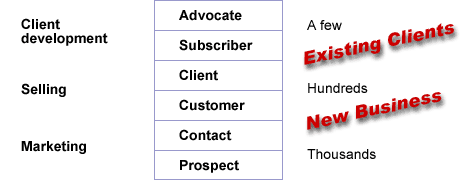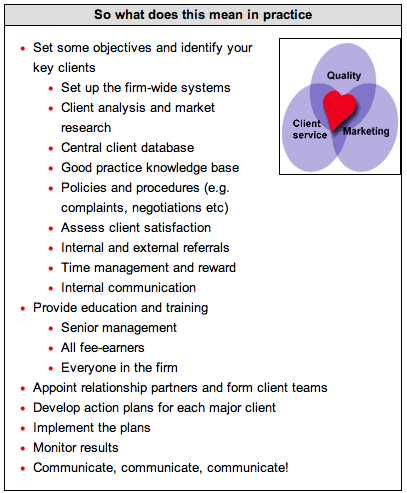CRM or Client Relationship Management is a very big topic that is of vital importance to the professions. In fact, it is interesting that it only really became a big topic in the wider commercial and industrial markets relatively recently (a few years back) whereas in some respects the professions have always operated to the principals even if they did not realise it! But people often confuse the concept of Client Relationship Management with the systems that hold the data to support this activity.
The starting point is recognising that in just about every professional practice, existing clients account for over 80% of the income each year. Various research studies show that it is far more cost effective and efficient to generate new work by developing existing clients rather than by chasing new clients. Also, 90% of professional recommendations arise as a result of good relationships (i.e. not expertise or results).
CRM is often explained by reference to the client relationship ladder:
Building client relationships
(Client Relationship Management – CRM)
Starting at the base of the ladder there are usually a very large number of individuals or organisations who could potentially give you work (prospects). Of these, you will probably know or have contacted only a few thousand (contacts). An even smaller number – perhaps several hundred – might have given you one piece of work at some point (customer). Then there might be even less – just a few hundred – who give you work on a regular basis (client). Some clients – perhaps around 30-50 – will subscribe to a number of your services by using several professionals and/or departments and their services. Finally, there will be just a handful of clients who use you a lot and who actively tell other people how great you are (advocates).
You use marketing techniques to capture prospects and develop contacts. You use selling to increase the amount clients use you and client development (account management) techniques to convert good clients into subscribers and advocates – this relates back to the business development process shown in earlier FAQs.
Another way to look it is to consider how clients view the relationship with your firm:
| LEVEL 4 | Business Partner |
|---|---|
| LEVEL 3 | Value adder |
| LEVEL 2 | Product/Service Provider |
| LEVEL 1 | Commodity broker |
The relevance of these ideas lies at the heart of marketing strategies focused on providing a differentiated service for a premium price. The professional service firm’s “product” comprises two parts – the core product (e.g. the expertise in the law, property or finance) and the way in which that advice is delivered (i.e. the relationship between the client and all its interactions with the professional and support personnel at the firm). Clients will not pay a premium price for a commodity product or service that they think they can obtain from many other advisers. Therefore, many firms base their differentiation strategy around the way they interact with clients – the relationship. As it is difficult to achieve a consistent approach to relationship management – for it requires every member of the firm to work in a particular way and a host of systems to support them in doing so – it is less easy for competitors to copy.
Some people mistakenly think that CRM is just a comprehensive database of clients and contacts. Actually, a good database is a foundation for CRM but true CRM requires much more than this. At a simple level it requires a range of systems designed to ensure that all client touch points with the firm are managed effectively (i.e. client care procedures), then it requires all fee-earners to adhere to standards and to be alert to their responsibilities in day-to-day client relationships issues. The final level is the need for the most senior people within the firm to focus significant energy into developing and implementing proper client or account plans for the most important clients of the firm.
To illustrate how extensive a full CRM programme might be, consider some of the essential elements needed:
This is why you need to have a deep understanding of a) the firm’s overall objectives b) its strategic positioning c) its culture and resources d) its client base and competitors and e) its ability to assimilate change before developing a suitable CRM strategy.
I do not restrict access to the FAQs but I politely request that you let me know by email and acknowledge the source (www.kimtasso.com) if you wish to use the material anywhere.
As always, if there are particular topics you would like me to address in the future, please let me know. You will also find a source of more and up to date information on a broad range of management and marketing issues in the professions by checking out the blog where I also post regular reviews of books that might be helpful.




